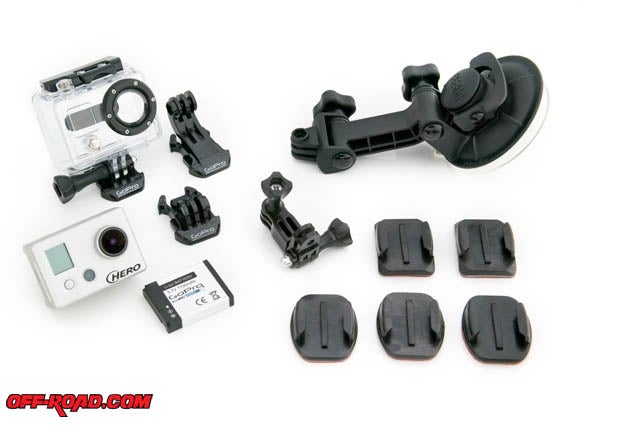
If you have any connection to the action sports realm, you probably either know someone who has or wants a GoPro camera. The small, portable video cameras have made a big mark on the action sports scene, and with the release of its newest model Ė the HD Hero, which is capable of shooting 1080p video Ė the company has even launched a national advertising campaign using only footage shot from its cameras. The HD Hero has given weekend warriors, professional athletes, wannabes, pro and up-and-coming cinematographers and anyone in between the ability to shoot high-qualify video of their adventures.
GoPro recently sent Off-Road.com a new HD Hero camera to test out, and weíve spent the last few weeks gathering video footage to get a fair assessment. GoPro also included a number of housings and attachments for any situation in which we might use the camera. The HD Hero actually comes relatively well-equipped for immediate use, though a specific package can be purchased to suit the userís needs.
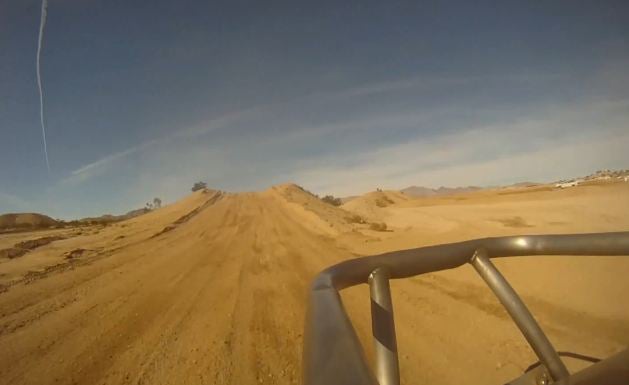
The HD Motorsports Hero pack ($299) that we were sent includes a suction-cup mount for attaching it to a vehicle and some extra adhesive mounts. We also got our hands on the Roll Bar Mount Kit for off-road vehicles (the suction cup attachment works fine for most non-race action), the Surf Hero Expansion Kit, and a few replacement pieces in case we had any snags along the way. For the Average Joe, The HD Hero Naked kit Ė which comes with the standard waterproof housing, one adhesive mount, camera and battery Ė is a great place to start since it can be purchased for $259 and the additional pieces and mounts can always be purchases separately.
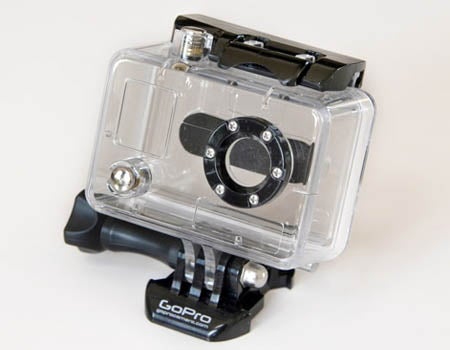 The HD Hero is capable of shooting 1080p video, and it can shoot automatic 5-megapixel photos at 2-, 5-, 10-, 30- and 60-second intervals. The housing included with the HD Hero is waterproof up to 180 feet. We didnít test its depth claims first hand, but it did keep the rain and mud out during some dirt bike rides and off-road racing, and it was taken into Southern California surf a number of times without a drop of water getting inside.
The HD Hero is capable of shooting 1080p video, and it can shoot automatic 5-megapixel photos at 2-, 5-, 10-, 30- and 60-second intervals. The housing included with the HD Hero is waterproof up to 180 feet. We didnít test its depth claims first hand, but it did keep the rain and mud out during some dirt bike rides and off-road racing, and it was taken into Southern California surf a number of times without a drop of water getting inside.
For the review, we were probably like most people. We pulled the unit out of the package, charged it, glanced at the directions, and then packed it away for the next day. The camera itself looks like a square-shaped miniature digital camera. The lens is a small, fixed-focus wide-angle lens. While shooting at 720p or 960p, GoPro says the angle of view is 170 degrees, while in 1080p mode the angle is reduced some to 127 degrees. The lens feature an f/2.8 aperture, which photography buffs will tell you helps its performance in low-light situations (and if youíve purchased a digital SLR recently with removable lens, thatís why the f/2.8 lens is $1,000 compared to the f/4.0 lens thatís $100). The video format the HD Hero spits out is MPEG4, which is compatible for both Windows and Mac.
The HD Hero also has a microphone, allowing you to capture the sites and sounds of your adventure Ė albeit slightly muffled through the protective housing. The camera body features a memory card slot that can accommodate up to a 32GB flash memory card; we, for example, used a 16GB card, shooting at the stock video setting of 960p, which allowed us to record for the full 2.5 hours that GoPro says the rechargeable 1100 mAh lithium-ion battery will last on a complete charge. Recharging only takes a few hours for a full charge.
Our first use was during a dirt bike ride in Southern California. We mounted a quick-release mount to the visor of our helmet, attached the camera, turned it on, and off we went. With clouds and intermittent rain, we only got decent footage on the first day because of the weather, and since we didnít pay close enough attention to the directions, we also only recorded half the time. The light rain was a good test, though, because it showed us that the curved lens port helps wick away rain drops while riding.
Video Note: To watch the version in HD, visit our YouTube page.
There are two buttons on the camera, and both serve the same purpose. Hold it for a few seconds to turn it on; once on, click it to cycle through photo mode, video mode, and timed photos; a longer hold will make the unit beep and light up seven times to turn off. To know when itís recording, simply make sure the red light is flashing and thereís a video icon on the digital screen next to the lens.
We ventured back out with the camera again to ride in the Southern California high desert, and this time, the weather was considerably better. We thought the footage the first day was cool to watch, but with no rain drops and more sunshine the video looked even better.
Just a few weeks ago, we had the chance to put it on Steven Eugenio and Adam Pfankuchís Class 12 racecar at the SCORE Laughlin Desert Challenge. We got some great footage before mud coated the lens. Thatís inevitable in off-road sports, which shows why camera placement is very important. This experience also proved just how well protected the camera is and pointed out another cool aspect of the GoPro system. Somewhere during the race a rock (or 10) made some nicks in the lens port. No damaged was made to the camera, but we were bummed at the thought that we needed to replace the entire housing. But, there are actually lens port kits that arenít horribly expensive available to purchase on the GoPro site Ė pretty easy fix.
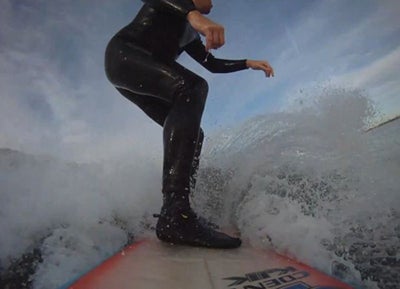 Although it has nothing to do with off-roading, we couldnít help but take the HD Hero in the water to see its full capabilities. Besides, weíve used full-on SLR surf housings before, so we were curious if the little surf housing worked as well as advertised. We mounted the surf kit to a board, made sure everything looked secure, and ventured out to Newport and Huntington Beach a few times. Much like on the dirt bike and racecar, the mounts are very secure, and despite our reluctance to put the unit under water, the housing didnít let a drop of water inside. We also learned that you can quickly start and stop the footage instead of shooting video of nothing while waiting for waves. That makes it easier to edit once home.
Although it has nothing to do with off-roading, we couldnít help but take the HD Hero in the water to see its full capabilities. Besides, weíve used full-on SLR surf housings before, so we were curious if the little surf housing worked as well as advertised. We mounted the surf kit to a board, made sure everything looked secure, and ventured out to Newport and Huntington Beach a few times. Much like on the dirt bike and racecar, the mounts are very secure, and despite our reluctance to put the unit under water, the housing didnít let a drop of water inside. We also learned that you can quickly start and stop the footage instead of shooting video of nothing while waiting for waves. That makes it easier to edit once home.
For the video footage, we edited the video on a PC in the current 2011 version of Windows Movie Maker. We made a point to not have one of our video editors put together the movie. We have somewhat limited editing skills but were still able to produce some cool footage. We kept it simple and shot all of the video on the standard setting of R4, which is a 960p. Moving up to 1080p improves quality slightly but would give us less of a wide-angle view, so we kept it on the standard setting. After importing the video (and allowing Movie Maker to compress the file), itís a matter of sorting through the footage, finding good material, and then piecing it together. Itís nothing the Average Joe couldnít do with a little practice, and it proved just to us just how user friendly the GoPro Hero can be.
Overall, we are very impressed with this little camera. It can do so much more than our uses, but weíre still getting the hang of it. For it capability and price tag under $300, the HD Hero is worth every penny for off-roaders who want to capture the action from their ride. Itís a great way to tell your story, and itís also good for a laugh or two if you managed to capture a crash Ö not that weíre saying that happened during our test.
For more information or to check out other videos, visit http://www.gopro.com/.

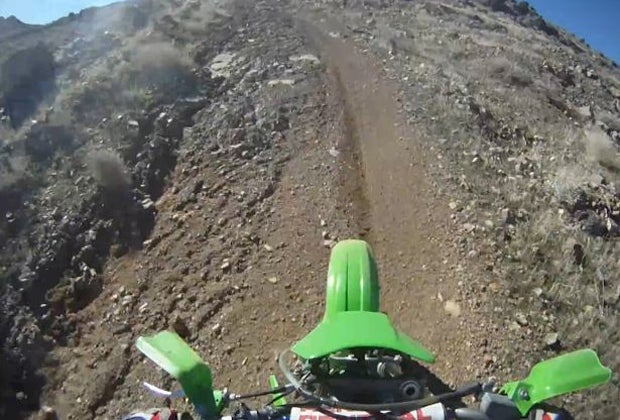

 Your Privacy Choices
Your Privacy Choices